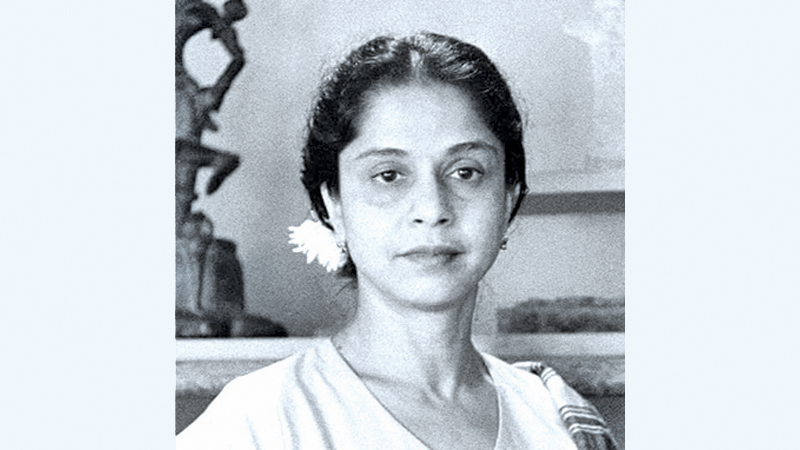- The first Asian representative of CIAM (Congrès Interna tionaux d’Architecture Moderne) in 1947
-
The first Asian woman to be elected an associate of the Royal Institute of British Architects (RIBA) in 1948.
Minnette De Silva is regarded as Sri Lanka’s first woman architect, and one of the first woman architects to establish her own architectural practice called ‘The Studio of Modern Architecture’ in Kandy in 1948
A talented prodigy, she has moved with Pablo Picasso.
Asia’s First Female Architect is Sri Lankan Minnette De Silva who became the first Asian woman to be elected an associate of the Royal Institute of British Architects (RIBA) in 1948.
She was also the first Asian representative of CIAM (Congrès Internationaux d’Architecture Moderne) in 1947 and was one of the founding members of the architectural publication Marg.
While in London she wrote the whole section on South Asian architecture in the new (18th) edition of Banister Fletcher’s A History of Architecture.De Silva was also engaged in writing and scholarly debates, publishing several key texts about housing, regionalism, architectural history in relation to
Asia, as well as her own architectural projects. De Silva was also a respected teacher, and taught Architectural History with a particular focus on Asia at the University of Hong Kong from 1975 to 1980.
A deeply intellectual mind, the Sri Lankan was awarded the SLIA Gold Medal for her contribution to architecture, in particular her pioneering work developing a ‘regional modernism for the tropics’. De Silva’s work and life are discussed in Flora Samuel’s book “Le Corbusier: Architect and Feminist”
Minnette de Silva was an internationally recognised architect, considered the pioneer of the modern architectural style in Sri Lanka.
The trailblazing Sri Lankan modernist architect
Sri Lankan architect Minnette de Silva is celebrated in a new book by author Anooradha Iyer Siddiq, who looks into the modernist’s work at the intersection of ecology, heritage and craftsmanship
BY LÉA TEUSCHER
PUBLISHED FEBRUARY 9, 2025
If you are not familiar with the work of Minnette de Silva, you may not be alone. Asked to name Sri Lanka’s most influential architect, many might go for Geoffrey Bawa, whose Lunuganga Estate you can now visit. Yet it would be unfair to forget this other regional modernist architecture pioneer of the tropical island country, de Silva (1918–1998), who founded the Studio of Modern Architecture in Kandy, Sri Lanka, in 1947 – one of the first women in the world to establish a professional architectural practice as sole principal.
Tour the work of Sri Lankan architect Minnette de Silva
Her story and projects are at last given the spotlight in a new book, Minnette de Silva: Intersections, by architectural historian Anooradha Iyer Siddiqi. Illustrated with new photography, drawings and archival material, the monograph is shaped around themes of ecology, society and heritage, with detailed presentations of de Silva’s significant projects built across Sri Lanka.
Hailing from a Sinhalese-Burgher family, with both her parents active in the anticolonial and universal franchise movements, De Silva first encountered architecture through a meeting with town planner Oliver Weerasinghe. She trained in Mumbai at Mistri and Bhedwar, led among others by Perin Mistri, one of the first women in India to practice architecture, but her studies were interrupted by her participation in the Quit India protests, which caused her to be expelled.
She then worked in the private office of Otto Koenigsberger, chief architect of the Princely State of Mysore, on a project developed under the industrialist JRD Tata: an extension to Jamshedpur, India’s first planned housing project for industrial workers. After the war, De Silva moved to London, where she was able to enroll in the Architectural Association in London and complete her studies, under, among other tutors, Arthur Korn of the MARS Group.
To mark her first commission in 1947 (a house in Kandy for her father’s business partner Algernon Karunaratne), De Silva founded her Studio of Modern Architecture, working from an extension she designed next to her family home, and which served as her base for her entire career.
Today, she is known for her designs and constructions encompassing housing projects, public institutions, settlement planning, and experiments in fabrication and handicraft design – most in Sri Lanka and some in India. Her practice treats architecture as a lived experience and a contemporary expression of the local traditions, with projects including the Kandyan Art Association building (1982–84) on Kandy’s central lake, and the Ceylon Match Factory (1958) in Colombo.
‘Her designs often integrated a 1920s continental European modernist idiom of reinforced concrete slabs on pilotis, with organic materials ranging from stone to grasses, as well as hand-fabricated elements by craftspeople working in traditions familiar in Kandy, such as weaving, lacquered wood, and terracotta tile relief,’ writes Siddiqi, who also note that De Silva was an engaged presence on the construction site and actively engaged the engineers and fabricators of buildings – a hands-on approach that saw her take private classes in modern weaving practices in order to better understand the work of the craftspeople she engaged.
To leave the last word to the architect herself: ‘Much of my work has been based on finding a workable synthesis of traditional and modern architecture.
Courtesy- The Blend







